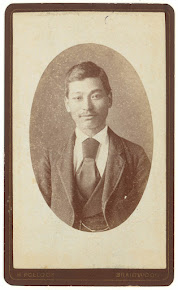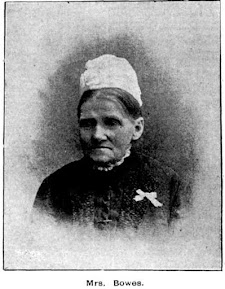An Immigrant who made good
Last Friday was Australia Day and we are a nation of immigrants, (with the exception of First Nations people the custodians of the island), in a country we call "home".
Many immigrants have progressed from rags to riches and there are many to choose from.
Today's blog relates to a man who came to this country and attempted to assimilate and smooth over many of the troubles with his heritage and living in Australia at the time.
MEI QUONG TART
Mei or Quong as he was widely known was born in in a village of the Guangdong province of China in 1850. At the age of 9 he was sent to Australia to accompany his uncle who was bringing a team of Chinese workers to work in the goldfields in the area of Braidwood and Araluen NSW. In Braidwood he lived with Thomas Forsyth, a Scot, who ran a store at Bell's Creek. Later he was taken in by the wealthy family of Robert Simpson and his wife, Alice, nee Want, who were charmed by the lad's Scottish accent! Under their tutelage he learnt the ways of a gentleman and converted to Christianity.
Simpson advised him on a large gold claim which proved very profitable, and his mining ventures made him a wealthy young man. With his wealth he built a cottage and a school for the miners' children and became prominent in local sporting activities. Quong helped the Chinese with employment and became a government interpreter for the district by the age of 21. He was granted a certificate of naturalisation and was then able to buy and own land. Quong joined many organisations such as the Manchester Unity and Oddfellow's Lodges and later became a Freemason. He often provided dinners and gifts for the Benevolent Society home at Liverpool, inmates of destitute asylums and for the newsboys of the Ashfield area.
Quong Tart in his youth - State Library of NSW
Quong visited China in 1881 in order to gain introductions and gather material in order to establish himself in Sydney as a tea and silk merchant. Upon his return he not only established himself as a merchant in tea and silk but opened several restaurants.
In 1886 he married an English school teacher, Margaret Scarlett much to the disapproval from both her and his family however, he travelled with her and their first born to China in 1888 to meet his mother. This visit proved to be successful, and Margaret was one of the first "European" women to travel in that area. Quong reported to authorities there of the anti-Chinese sentiment in Australia and urged the Imperial government to raise his concerns with the British Government.
Margaret Tart nee Scarlett - State Library of NSW
1889 saw Quong open an elaborate restaurant in King Street and soon after Quong was appointed to serve in the royal commission into alleged Chinese immorality and gambling that was also tasked to investigate police corruption in Chinatown. He worked tirelessly to try to bring about an end to the opium trade and stop the operations of the corrupt gambling houses in Sydney and the Victorian goldfields. For his effort he was made a fifth class Mandarin of the Crystal Button, the equivalent of a Knighthood and in 1894 this award was increased to the fourth Blue Button plus Peacock feather making him the mostly highly awarded person in Australia.
When the Queen Victoria Building opened in 1898, he opened the Elite Tea Rooms with a grand staircase leading up to the first floor Elite Hall which had capacity for 500 people and included a stage for events. Small function rooms provided meeting areas for groups to gather such as the members of the Womanhood Suffrage League of NSW. A number of other tea rooms were opened, and they were attended by all manner of society. Being a canny person and able to "read the room" as we would say today, he provided after-theatre suppers, picnic hampers for those workers taking advantage of increased leisure hours (no doubt many of those hampers were taken to Rookwood for lunch on a Sunday) and started to sell tea in small packets in order for more people to be able to afford the tea "ritual".
Quong Tart outside of one of his tea rooms - Museums of History NSW
Quong Tart had two sons and four daughters whom, although Anglican himself, he baptised in different denominations to avoid any charges of prejudice.
He lived with Margaret and his family in the mansion "Gallop House" in Ashfield whilst his four daughters attended the nearby Presbyterian Ladies College in Croydon.
On 19th August 1902, Quong Tart was brutally bashed with an iron bar and robbed of a few pounds at his office in the Queen Victoria Building, a crime that shocked Sydney. The attacker described as a "dim-witted thug" was jailed for 12 years, a light sentence for a crime that was labeled a robbery gone wrong.
Quong never fully recovered from this attack and died from pleurisy at his Ashfield home on 26th July 1903, aged 53. His funeral, as expected was a huge one attended by people from all classes of Society and nationalities. Thousands of people gathered to pay their last respects. Quong Tart was laid to rest dressed in his ceremonial robes of a Mandarin of the Blue Button, under his masonic apron.
Quong Tart in ceremonial dress - Wikipedia
Quong Tart lies in the old Anglican area not far from the No.1 Mortuary Station with his wife Margaret who died in 1916 and eldest daughter Alice. Adjacent graves hold other family members.
Quong Tart monument at Rookwood - author's own collection
Quong Tart was a man who had his feet planted between two cultures and who tried to broker peace in a time of fierce Chinese resentment due to the White Australia Policy. Many believe Quong's attack and death was more than a burglary mishap with suspicions that it could have been arranged by resentful people from the western world or jealous Chinese businessmen. I guess we will never really know.
There are many sources available in relation to Quong Tart and I have utilised ancestry.com, the Australian Dictionary of Biography by EJ Lea-Scarlett, Wikipedia, State Library of NSW, and many others from Google searches.
To commemorate his life, a statue was erected for him in Ashfield in 1998. Recently a blue plaque was erected outside of his home in Ashfield, now part of the Uniting Care aged care complex.
Bust of Quong Tart in Hercules Street Ashfield - Wikipedia
If you have any comments regarding this blog or Quong Tart, please add them here or at the group facebook page found under
rookwoodcemeterydiscoveries
or simply send me a personal message via
lorainepunch@gmail.com
Until next week.........

%20state%20librayr%20of%20nsw.jpg)









Comments
Post a Comment